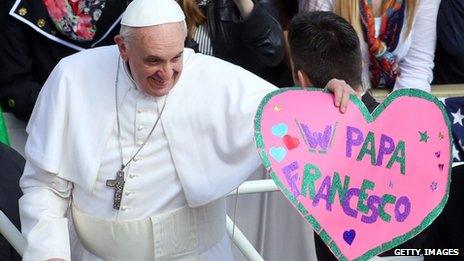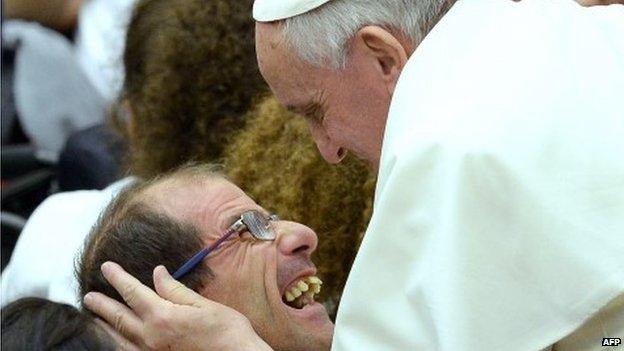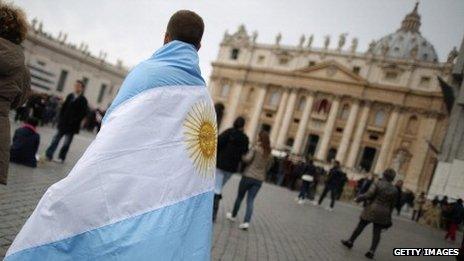Pope Francis 'scores goals' for image of Catholic Church
- Published

Pope Francis "has energised the Catholic Church" says Gerard O'Connell
Very recently, it was hard to find a good word about the Catholic Church in the world's press, amid sex abuse and other scandals. That has changed dramatically, with Pope Francis riding the crest of a wave that has culminated in him being named Time magazine's person of the year.
We asked Vatican commentator Gerard O'Connell, who reported on the PR failures three years ago, external, to examine what has changed.
Pope Francis has been a godsend to the Catholic Church and to the Vatican. Prior to his election, the Vatican was bogged down with a negative image in the world's eyes, due to scandals and blunders.
It was in freefall, with little sign of relief on the horizon. But after Benedict XVI resigned on 28 February, and Argentina's Cardinal Jorge Mario Bergoglio was elected Pope 13 days later, the tide turned.
Ever since Pope Francis made his first appearance on the central balcony of St Peter's Basilica on the evening of 13 March, the Vatican has basked in the glow of positive media as he touched hearts across the globe by embracing people with deformities, reaching out to the mentally and physically disabled, external, kissing the feet of young prisoners, including a Muslim woman, and launching a global consultation on the family.
Has the first-ever Latin American Pope been responsible for this dramatic transformation, or has the Vatican suddenly become media savvy thanks to a carefully honed communications strategy?
I put that question to Greg Burke, 53, a former Fox News TV reporter whom the Vatican hired in July 2012 to help improve its failing media strategy. International media recently credited him with being behind this amazing turnaround in the global perception of the Vatican.
They hailed him as the "PR genius", external, "marketing mastermind", who has quietly worked behind the scenes to project Pope Francis into the international limelight and lead the Catholic Church out of one of its darkest periods in recent history.

The Pope's embrace of disabled people has won him many admirers
"Give me a break!" Burke retorted sharply when I put this theory to him. Dismissing it as a total misrepresentation of reality, he insisted: "It's him! It's him!", referring to Pope Francis. "He's the one who's done all this." Then he confided: "Yes, we have a strategy: kick the ball to Francis and he scores the goals! He's better than Maradona and Messi combined."
He cited two high-profile initiatives that Francis decided to undertake at short notice and "scored goals": his visit to Lampedusa to highlight the tragic plight of migrants from Africa and the Middle East who drowned at sea while fleeing poverty and war in search of a better life in Europe; and his peace initiative for Syria, involving a day of fasting and prayer just as the US was considering bombing the country. "The ideas were his, we just helped with the media," Burke recalled.
Encounter, not confrontation
Francis tends to prefer actions to words to convey the message of Jesus, and frequently takes the Vatican off-guard with spontaneous gestures of compassion, love and tenderness. "We never know what he will do next," Burke admitted.
"Do you seriously think that we planned to have the Pope embrace and kiss the man with boils? Or respond with such tenderness to the five-year-old boy that came up and stayed beside him while he was addressing a large audience?" Burke asked me. He was referring to two recent happenings in St Peter's Square which photographers and TV cameras immortalised and broadcast worldwide.
"The Francis effect" has energised the Catholic Church and opened many people's hearts, in Asia and the Middle East too, but it has also led to rising expectations that this Jesuit Pope will introduce radical changes in the Church's stance towards women, the divorced and remarried, homosexuals and many other issues.
This is causing concern among many Vatican officials and Church leaders, including such ardent supporters as Cardinal Walter Kasper who, in a new biography of Francis (Francisco: Vida y Revolucion, by Elisabetta Pique), warned against "exaggerated expectations that will necessarily end in new disappointments" because "the new Pope can renew the Church, but he cannot invent a new Church".
Vatican officials are aware that "the golden glow" could fade under new attacks or disillusionment, even if "the Teflon Pope" can help soften their impact.
One such attack came last week when the Vatican was accused of not responding adequately to the UN Committee for the Rights of the Child. For this reason they are working hard behind the scenes to overcome past communications failings and develop an integrated media strategy that can better respond to future challenges.

Pope Francis rivals the footballer Lionel Messi as one of Argentina's icons
Many believe this will require structural changes too, as Archbishop Claudio Maria Celli, head of its Council for Social Communications, acknowledged recently. He noted that besides his office, which handles the new social media and has links with the world's broadcasters, there are several largely independent actors on the Vatican media front: the Press Office, Vatican Radio that broadcasts in 45 languages, L'Osservatore Romano - the 150-year-old Vatican daily with weekly editions in various languages - and Vatican TV.
While these co-operate to some extent, they are far from being a well-co-ordinated, fully-integrated media operation. But all that could change over the next two years when Francis reveals his reform plan for the Roman Curia, which could result in the Vatican establishing an overall Ministry for Communications.
Right now, Archbishop Celli told me, the Vatican media offices are promoting "the culture of encounter" that Francis is insisting on, together with "transparency" and rejection of "the idea of confrontation". Francis is blazing the trail, but how well the Vatican team follows him remains to be seen.